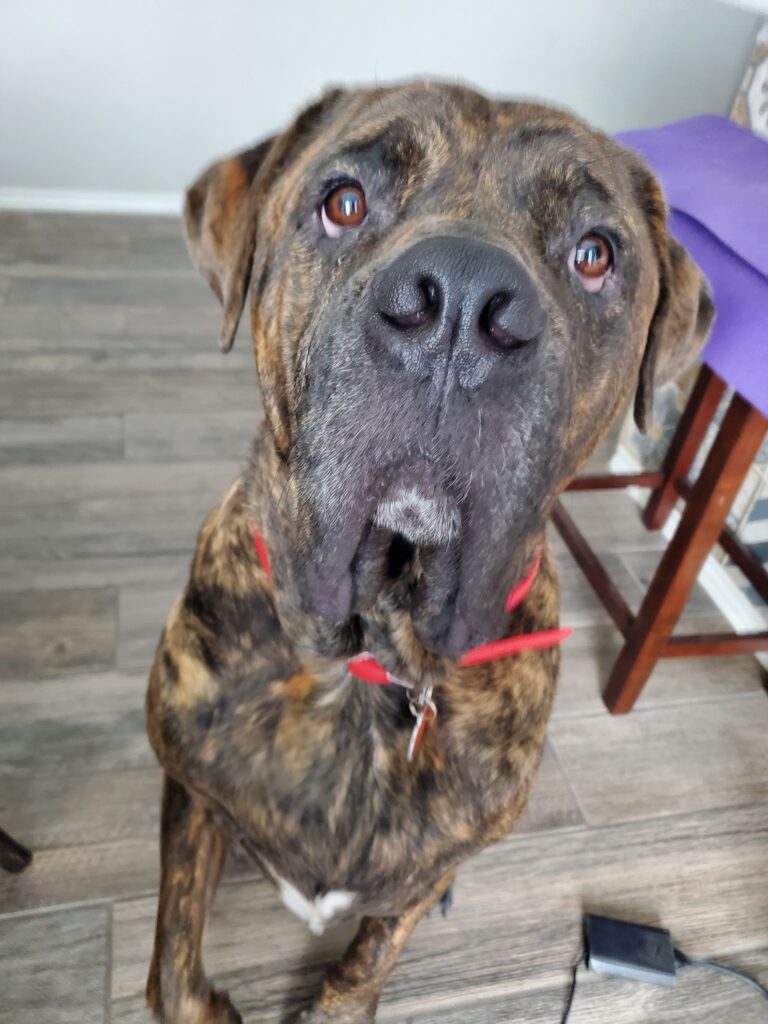Mastiff Skin Problems Are Common
So you have a wonderful pet mastiff, who seems to have acquired a skin condition of some kind. This is always a heartbreaking situation, especially when you don’t get the help you need right away. No one wants to see their pet suffer.
Many dog breeds have health concerns, some minor, some major. Many mastiff owners struggle with skin and coat issues. Coats often can become dull and thin, and some mastiffs are constantly scratching or biting at their skin.
Common Mastiff Skin Problems
Mastiffs are prone to a variety of skin conditions. Some of the most common problems include:
- Fleas and Ticks: These parasites can cause itching and irritation, leading to infections if left untreated.
- Dermatitis: Inflammation of the skin, often caused by mastiff allergies or irritants.
- Pyoderma: A bacterial skin infection that can cause crusty lesions and an unpleasant smell.
Parasites (Fleas and Ticks):
Some skin problems are common to all dogs, including mastiffs. Mastiff skin problems are probably most familiar with parasites, such as fleas and ticks. These insects burrow into your dog’s skin and bite him, which can lead to chronic skin irritation and infection. If over-the-counter remedies for fleas are not sufficient to rid your dog of pests, your veterinarian can prescribe more effective medications.
Dealing with Parasites (Fleas and Ticks)
Fleas and ticks are common culprits of english mastiff skin problems. If itching and irritation are not treated they can get infections. These pesky parasites latch onto your Mastiff’s skin, leading to discomfort and potential secondary infections.
Treatment Options:
- Flea collars, topical treatments, or flea shampoos.
- Flea sprays that are safe and herbal for dogs and suitable for use on bedding or in areas your dog frequents.
- Oral flea and tick preventatives that are highly effective and easy to administer.
- Prescription-strength flea treatments for severe infestations.
Have a look at the Top 10 flea and tick products.
Dermatitis
The next and one of the most common mastiff skin issues is dermatitis or inflammation of the skin. This is often caused by mastiff allergies to food, chemicals, or other substances. the best way to determine what is causing this is through experimentation. Try changing things such as the dog’s food or your clothing detergent, to see what makes a difference.
Dealing with Dermatitis
Dermatitis, or skin inflammation, can result from food allergies, environmental irritants, or even certain grooming products. Mastiffs with dermatitis often experience red, itchy skin and may scratch excessively.
Treatment Options:
- Switch to a hypoallergenic or limited-ingredient dog food if you suspect food allergies symptoms.
- Gradually introduce new foods to identify any potential allergens.
- Use natural or mild dog shampoos and avoid strong household cleaners that may be causing irritation.
- Consult a vet to perform mastiff allergy tests if the cause is unknown.
- Anti-inflammatory medications, antihistamines, or medicated shampoos may be prescribed.
- To improve your english mastiff skin conditions, start with improving the condition of their dull coat by incorporating Omega-3 fatty acid supplements into their food.
Pyoderma
Finally, as a mastiff owner you should be aware of a condition called pyoderma, which is a cutaneous bacterial infection of the skin. other bacteria can also be found. The bacteria commonly involved is Staphylococcus intermedius.
Staphylococcus intermedius is a normal inhabitant of dogs mucous membranes and transiently colonizes the skin without necessarily causing disease unless some other factor leads to impairment of the skins’ resistance. Most dog skin is rather resistant to bacterial disease, and pyoderma is usually regarded as a secondary phenomenon. Pyoderma is typically characterized by crusty black lesions on the dog’s back and neck area.
Dealing with Pyoderma
Pyoderma is a bacterial skin infection that often appears as crusty lesions on your dog’s skin and can give off a strong odor. It’s usually secondary to other skin issues, so it’s crucial to treat the underlying cause.
Treatment Options:
- Oral or topical antibiotics as prescribed by a veterinarian to tackle the bacterial infection.
- In some cases, medicated shampoos containing chlorhexidine or benzoyl peroxide can help control symptoms.
- Bathe your Mastiff with vet-recommended antibacterial shampoos to reduce bacterial buildup.
- Keep infected areas clean and dry to prevent further irritation.
Pustules are usually the hallmark of the disease but usually not seen since they are so fragile and burst before we recognize them. The first lesions are usually papules that will sometimes form pustules if seen. These are found usually in the groin, ventral abdomen, and axilla commonly. In some cases the dorsal trunk and neck are involved and patchy hair loss can be seen at these sites. By the time I see some of these cases, there are not many pustules or papules. It is in the more chronic state. It makes the dog itchy and miserable. It will probably make you miserable as well, since it is usually accompanied by a nasty smell and makes the dog’s skin and fur unnaturally oily. This is due to the production of inflammatory toxins and enzymes by the bacteria.
If you suspect that your mastiff has pyoderma, you should take him to the vet right away. The quicker you can get his skin disease under control. the happier you both will be.
Dr. Robin Smith, DVM has written an excellent in-depth article on diagnosing and treating skin problems in mastiffs. Read more here.
Source by Aaron Michaels
5 Fun Facts About Mastiffs

1. Mastiffs Can Have A Longer Puppy Phase
Mastiffs do not reach their final physical and mental maturity until they are three years old.

2. Big Standards
While there is no maximum height, there is a minimum.
Female Shoulder Height: 27.5″
Male Shoulder Height: 30″
There is no weight standard for males or females.

3. Record-Setting
A mastiff once held the world’s record for the largest dog.
In 1989, an 8-year old mastiff named Zorba, was 37″ tall (shoulder), 8’3″ long from nose to tail, and weighed 343 pounds.

4. Coming To America
A mastiff reportedly came to America on the Mayflower.

5. Oh Baby
Mastiffs have some of the largest litters at 10-12 puppies.
The largest mastiff litter on record was 24 puppies, of which 20 survived past the first week.











